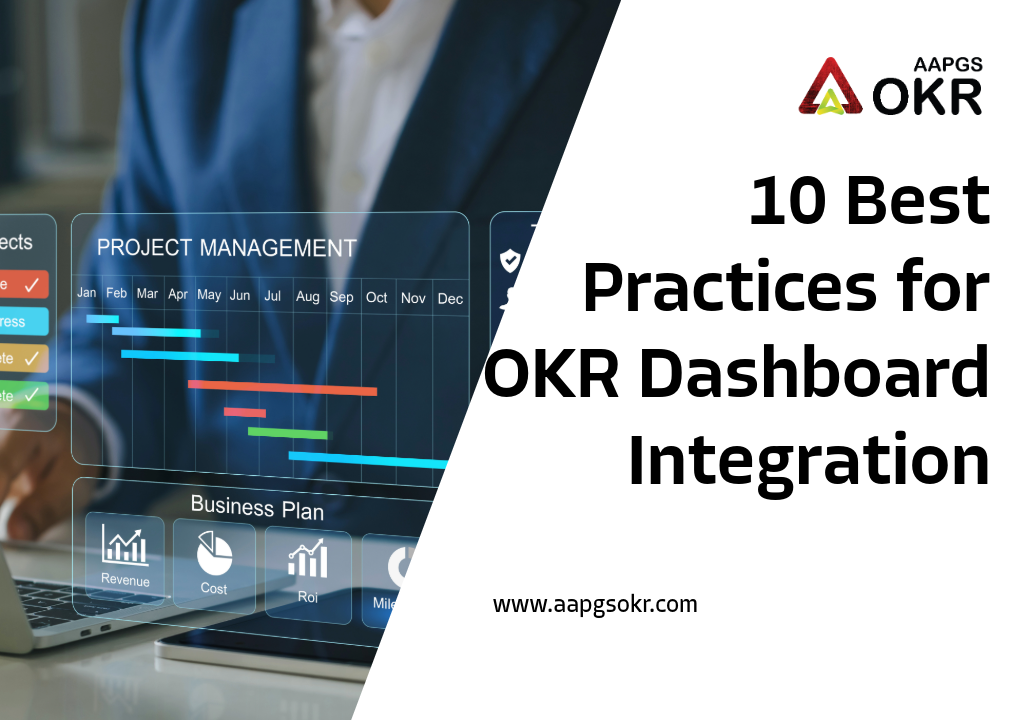Welcome to the official AAPGS OKR blog !
Greetings from the official AAPGS OKR blog! Here, we discuss best practices, updates, and professional opinions on managing OKRs (Objectives and Key Results). Keep up with the most recent tactics, tools, and trends to help your company accomplish its objectives effectively.
Getting Started :
In order to help businesses increase team accountability, streamline goal tracking, and improve transparency, this blog examines the top ten OKR dashboard integration best practices. These procedures will help organizations get the most out of their OKR dashboards, from establishing specific goals to guaranteeing data accuracy and permitting real-time updates. Following these tactics can help your teams remain motivated, aligned, and focused on what really produces results, regardless of how big or small your business is.
Why We Chose 10 Best Practices for OKR Dashboard Integration :
Since successful goal tracking and alignment are essential to organizational success, we decided to focus on "10 Best Practices for OKR Dashboard Integration." Businesses can set clear goals, track their progress, and make sure teams are working toward the same objectives by using OKRs (Objectives and Key Results). However, because of inadequate integration, ambiguous goals, or irregular updates, many organizations find it difficult to maximize the benefits of their dashboards. This blog offers helpful advice on how to optimize OKR dashboards, enhance real-time tracking, accountability, and alignment, and make sure that teams can accomplish their goals effectively by showcasing best practices. For managers, team leaders, and organizations looking to increase productivity and optimize the value of their OKR systems, this topic is extremely pertinent.
What is OKR Dashboard Integration ?
The process of integrating an OKR (Objectives and Key Results) tracking system with additional platforms, tools, or data sources inside a company is known as OKR dashboard integration. Through this integration, data from various teams, departments, or software programs is automatically synchronized in a single dashboard. Managers and team members can thus track goals, measure important outcomes, and keep an eye on progress in real time without requiring manual updates.
OKR Dashboard Integration :
1. OKR Dashboard Integration :
OKR dashboard integration connects your OKR tracking tool with other business systems. This ensures that all objectives and key results are updated automatically, giving teams real-time visibility of progress and helping managers make informed decisions.
2. OKR Dashboard Best Practices :
Following OKR dashboard best practices makes your dashboard effective and easy to use. Use clear objectives, track measurable key results, and update data regularly. Visual charts and simple reports help teams stay aligned and focused on important goals.
3.OKR Management System :
An OKR management system centralizes all goals in one platform. It simplifies tracking, improves transparency, and ensures that teams are aligned with company objectives. Managers can quickly identify performance gaps and plan actions efficiently.
4.OKR Software Integration :
OKR software integration links your OKR tool with other applications like project management or communication software. It reduces manual updates, ensures data accuracy, and provides real-time tracking of objectives across teams, improving overall efficiency.
5.OKR Alignment Strategies :
Effective OKR alignment strategies connect individual, team, and company goals. Regular check-ins, transparent dashboards, and clear communication help teams understand their role in achieving overall objectives and improve collaboration.
Importance of OKR Dashboard Integration :
- For organizations to effectively align teams, monitor progress, and accomplish strategic goals, proper OKR dashboard integration is crucial.
- Businesses can guarantee that data is correct, current, and easily accessible by integrating OKR dashboards with other systems, such as project management, human resources, or communication tools.
- Managers can swiftly make well-informed decisions thanks to an integrated dashboard that offers real-time insights into goals and important outcomes.
- Because everyone can see their roles and contributions to the company's overall goals, it also improves team accountability and transparency.
- Additionally, goal alignment tactics are supported by efficient OKR dashboard integration, guaranteeing that team and individual goals contribute to the organization's overall vision.
- By simplifying the tracking and reporting process, it lowers manual labor, avoids mistakes, and boosts productivity.
Conclusion :
Effective team alignment, progress monitoring, and business goal achievement depend on proper OKR dashboard integration. Organizations can make sure their dashboards are accurate, user-friendly, and integrated with other tools to facilitate real-time insights and improved decision-making by adhering to these ten best practices. In addition to increasing accountability and transparency, implementing specific goals, significant key results, automated alerts, and frequent reviews boosts overall productivity. An effectively integrated OKR dashboard transforms from a tracking tool into a strategic asset that promotes performance, alignment, and quantifiable success throughout the company.

